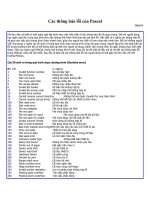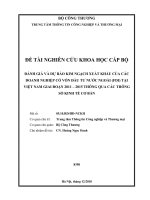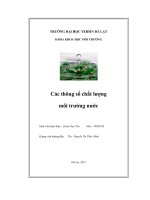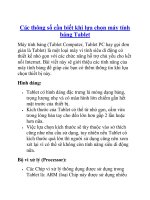Cac thong so ve hieu suat lam lanh
Bạn đang xem bản rút gọn của tài liệu. Xem và tải ngay bản đầy đủ của tài liệu tại đây (219.66 KB, 7 trang )
HVAC
Efficiency Definitions
Term
John Mix
page
EER
-
2
SEER
-
3
COP
-
4
HSPF
-
5
IPLV
-
6
May 2006
Carrier Corporation
1
Energy Efficiency Ratio (EER)
The energy efficiency ratio is used to evaluate the equipment’s efficiency while in the cooling mode.
EER is defined as the net cooling capacity (in Btuh) divided by the total electrical power input (in watts),
as shown in EQ – 1. EER is calculated at a single very specific operating point and is typically only
applied for commercial equipment > 6 nominal tons.
EER =
NetCapacity ( Btuh)
PowerInput (kW )
(see supplemental equations EQ 3-6)
EQ-1
For applicable units, manufacturers must rate their units per the ARI defined operating conditions. This
must officially be determined EER from actual laboratory test measurements, and results in an EERARI.
The ARI defined EER conditions are:
Evaporator Entering Air (EAT) = 80/67oF
Ambient air (condenser air) = 95oF
Specific static pressure requirements that vary with the tonnage.
No outside ventilation air is specified.
No specific indoor airflow rate.
However, the same equation can be applied at any other specific operating condition. In this case the
resulting value is an application specific EER value, or EERApp. Care must be taken not to confuse the
two…any application specific conditions which incur a larger load on the unit than what the ARI
conditions impose, will result in a lower energy efficiency ratio value.
Since the value for EER is expressed in Btuh/watts, it is not dimensionless, and is an “efficiency ratio” –
not a value of efficiency. Since the units are typically not mentioned when quoting EER values, it is
important not to interpret this as a “percentage” or “actual efficiency”. For example, a 9.7 EER value
does not meant that the unit is 9.7% efficient. In order to obtain an actual value for efficiency, the units
must be converted so they are similar terms in both the numerator and denominator.
For example, if a unit produces 220,000 Btuh of cooling with 22 kW of power input:
ex:
% Energy Efficiency =
220,000 Btuh
22,000( watts ) x3.414( Btuh / watt )
=2.9 %
EQ-2
This means that for every Btuh of electrical energy supplied, 2.9 Btuh of heat can be absorbed.
The EER rating evaluates how a unit will perform at one specific point. A higher value for
EER represents a higher efficiency at standard conditions.
Net Capacity = Gross Capacity – indoor fan motor heat
⎛ Bhp ∗ 746( watts / Bhp) ⎞
⎟⎟ x(3.414 Btuh / watt )
Indoor fan motor heat = ⎜⎜
⎝ motor _ efficiency ⎠
EQ-3
EQ-4
Total Power Input = compressor watts + Indoor fan motor watts + condenser fan motor watts EQ-5
⎛ actual _ power ( Bhp) x746( watts / Bhp) ⎞
⎟⎟ x(number _ of _ fans )
Fan motor input (watts) = ⎜⎜
motor _ efficiency
⎝
⎠
EQ-6
2
Seasonal Energy Efficiency Ratio (SEER)
The Seasonal Energy Efficiency Ratio is similar to the EER in that its purpose is to represent the
efficiency of the unit while in the cooling mode. However, there are two major differences between them.
First, the SEER attempts to take into account the energy consumption due to the cycling of the fan motors
and compressors. Second, EER is calculated only at one point (the ARI standard conditions) where SEER
is calculated at two different points that simulate operation at higher and lower humidity levels for
entering conditions.
According to the industry definition, the SEER rating is only defined for units 5 tons and less that operate
on single phase current. Nonetheless, it is industry convention to apply the SEER rating to single and
three phase equipment that are < 5 tons. Also, just like an EERApp the SEER formula is sometimes
calculated for larger equipment.
The SEER calculation requires performance testing and measurements at two different points, as outlined
below. The first point is intended to simulate dry coil conditions and is evaporator entering air (EAT) of
80/57oF and ambient air of 82oF. The unit is operated at this point and performance measurements are
taken. Next, the unit is cycled on and off and power measurements are taken. Then, the same procedure
is done at EAT = 80/67oF with 82oF ambient, to simulate wet coil conditions.
Calculating SEER involves laboratory testing, in a similar manner to all other rating values, with the
exception that SEER requires power measurements to be recorded while the unit is in steady state
operation, upon start-up and while the unit is at rest (there can still be some amp draw even while the
compressors are not running due to potential operation of the fan motor, crankcase heaters, etc). SEER is
impossible to calculate without a considerable amount of specific test data. Similarly to EER, the SEER
is not a dimensionless value, but is always quoted as a pure number (i.e. no units).
SEER ≈
weighted average of EER values at all four measurement conditions
EQ-7
Many times people try to derive the SEER value from the EER value. However, this is impossible
without laboratory test data. To do so requires calculating of a Degredation Factor ( CD as shown in
EQ–8), which can only be determine from laboratory testing at the various SEER defined operating
conditions.
SEER = EER ( 1 – CD/2 )
where CD = the Degredation Factor
EQ-8
The SEER evaluates a unit’s performance under two different conditions ; high and low
humidity with less than design ambient conditions. A higher value of SEER represents a
higher cooling efficiency.
3
Coefficient of Performance (COP)
The coefficient of performance is used to measure the unit’s efficiency while in the heating mode and is
applied to heat pumps, of any nominal cooling capacity, that operates on three phase current. To evaluate
a heat pump’s efficiency while in cooling mode, EER or SEER must be used. The COP is a
dimensionless value defined as the energy produced by the heat pump (in watts) divided by the energy
consumed by the heat pump (in watts). In an air to air heat pump, the evaporating refrigerant moves heat
from the outside air (when in heating mode) and this heat plus the heat equivalent of the work of
compression is rejected to the recirculated air flowing over the condenser coil and to the space to be
heated. There is always heat energy in the outside air, however, at lower temperatures, it becomes more
difficult to extract.
Therefore the COP decreases at lower ambient and the ARI COP rating is calculated at two different
ambient temperatures (47oF and 17oF). The formula for calculating COP is shown below in EQ–9.
COP =
Net Capacity (watts)
Power Input (watts)
(Gross Cooling capacity) – (Supply fan heat)
=
supply fan + compressor(s) + condenser fan(s)
EQ-9
Thus, a heat pump with a COP = 2.5 would produce two and a half times as much heat than the heat
equivalent of the watts input. If electrical resistance heat is used to condition the space, it is by definition,
100% efficient. In this case only 1 watt of heat would be obtained for every watt input, and the resulting
COP would be equal to 1.
COP represents the efficiency of a heat pump while in the heating mode. A higher value
of COP reflects a higher heating efficiency.
4
Heating Seasonal Performance Factor (HSPF)
The Heating Seasonal Performance Factor is used to measure a unit’s efficiency while in the heating
mode and applies only to heatpumps. It is defined as the total heating output (including supplementary
electric heat) divided by the total electric power necessary to maintain building heating requirements for
its normal annual usage period. The units are Btuh divided by Watt-hours for the same period. The
HSPF is only applied to heat pumps (in heating mode) that operate on single phase current and have a
nominal cooling capacity of less than 5.5 tons.
Since HSPF represents a seasonally corrected heating efficiency, the first step in the calculation involves
the hours of operation for different geographic locations and different modes of operation. To accomplish
this, the country has been broken up into different regions reflecting the amount of time spent in a
particular mode of operation. The heating regions map is shown in Figure 1, and a similar map exists that
represents hours spent in cooling mode.
By factoring in the total hours of operation in each mode, as well as the design conditions for each area,
the HSPF can be calculated using EQ-10.
(total heating output during normal usage period)
HSPF =
(total electric power input during normal usage period)
EQ-10
Fig. 1 – HSPF Heating Zones
5
Integrated Part Load Value (IPLV)
The Integrated Part Load Value was developed to evaluate the equipment’s energy consumption in the
cooling mode while it is operating at less than full capacity. The IPLV can essentially be described as a
weighted average of the energy efficiency ration (EER) calculated at each stage of unloading at which the
unit can operate.
Thus, the IPLV is similar to EER and SEER in that all three are intended to represent the unit’s cooling
efficiency. The significant difference between them is that the EER is calculated at one very specific
point while IPLV is calculated over the unit’s entire range of unloading operation. One major difference
between the SEER and IPLV values is that SEER takes into account the cycling of the equipment, but
does not actually unload the compressors like IPLV does. The IPLV can be of significant importance
since a unit typically operates at full capacity only a small fraction of the time it is in use.
In order to properly integrate IPLV, it is important to understand how the value is calculated. IPLV is a
function of two independent variables; Part-Load-EER and the Part-Load-Factor (PLF). IPLV is
mathematically represented by the formula shown in EQ-11 and EQ-12.
PLF = A0 + (A1 x Q) + (A2 x Q2) + (A3 x Q3) +(A4 x Q4) + (A5 x Q5) + (A6 x Q6)
EQ-12
Where:
Q = % of full-load capacity at part-load rating conditions
A0 through A6 are constants given by the part-load curve
IPLV = (PLF1 – PLF2)[(EER1 + EER2)/2]
EQ-11
+ (PLF2 – PLF3)[(EER2 + EER3)/2]
+ (PLFn-1 – PLFn)[(EERn-1 + EERn)/2]
+ (PLFn)(EERn)
1
Where:
PLF = Part Load Factor from EQ-12
n = total number of capacity steps
subscript 1 = 100% capacity and EER at part-load conditions
subscript 2 through n = Specific capacity steps
Since the IPLV is a function of the PLF, it is important that the
PLF curve is representative of how the unit will actually perform.
Otherwise, the IPLV value is meaningless. See Figure 2. Note
that at at ~ 80% of full load, the PLF is nearly equal to 1.0, while
at ~ 20% of full load, the PLF is only equal to ~ 0.07. Thus, the
PLF is a value that represents the percentage of the time a unit
typically spends operating at a given step of capacity. The exact
values of the PLF greatly determine the single IPLV value.
Also, the EER value for each step of capacity is dependent on the
load that is on the unit. The summation of all these values (as
shown in EQ-11) yields the single IPLV value that is published.
0
Figure 2
A unit that has few steps of unloading will have a higher Part Load Factor (which results in a higher
IPLV, all other factors being equal) than one that has many steps of unloading. This is true regardless of
whether or not the unit ever uses these steps of unloading. A higher IPLV does not mean that the unit is
6
more energy efficient. It is important to recognized that more stages of unloading will result in a lower
IPLV…which means it is more closely matched to the cooling load, will result in less over-cooling of the
conditioned space, and better humidity control. Additionally, more stages of unloading will result in less
cycling of the equipment. Continuous cycling of the equipment will typically lead to premature wear and
excessive current draw on start-up. Therefore, a unit with a lower IPLV is usually preferable unless the
unit will always operate near its full load value 100% of the time.
IPLV represents the cooling efficiency of a unit operating over its entire range of
unloading. Unless the unit will operate at or near its full load value 100% of the time, a
lower IPLV is more desirable for better overall performance.
NOTE: As of the date of this document, the current IPLV methodology is flawed because it does not
properly represent all the aspects of part load. ARI has defined a new procedure that is predicted to be
released in 2006. The levels will be about the same, but will also show credit for variable speed fans and
other part load improvements that the prior procedure does not properly consider.
7









